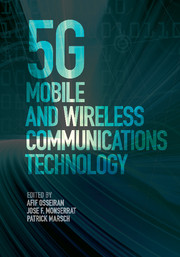Book contents
- Frontmatter
- Dedication
- Contents
- List of contributors
- Foreword
- Acknowledgments
- Acronyms
- 1 Introduction
- 2 5G use cases and system concept
- 3 The 5G architecture
- 4 Machine-type communications
- 5 Device-to-device (D2D) communications
- 6 Millimeter wave communications
- 7 The 5G radio-access technologies
- 8 Massive multiple-input multiple-output (MIMO) systems
- 9 Coordinated multi-point transmission in 5G
- 10 Relaying and wireless network coding
- 11 Interference management, mobility management, and dynamic reconfiguration
- 12 Spectrum
- 13 The 5G wireless propagation channel models
- 14 Simulation methodology
- Index
- References
1 - Introduction
Published online by Cambridge University Press: 05 June 2016
- Frontmatter
- Dedication
- Contents
- List of contributors
- Foreword
- Acknowledgments
- Acronyms
- 1 Introduction
- 2 5G use cases and system concept
- 3 The 5G architecture
- 4 Machine-type communications
- 5 Device-to-device (D2D) communications
- 6 Millimeter wave communications
- 7 The 5G radio-access technologies
- 8 Massive multiple-input multiple-output (MIMO) systems
- 9 Coordinated multi-point transmission in 5G
- 10 Relaying and wireless network coding
- 11 Interference management, mobility management, and dynamic reconfiguration
- 12 Spectrum
- 13 The 5G wireless propagation channel models
- 14 Simulation methodology
- Index
- References
Summary
Historical background
The Information and Communications Technology (ICT) sector was born in the twenty-first century out of a consolidation of two major industry sectors of the last century, the telecommunications industry and the computing industry. This book is designated to harness the momentum of the mobile telecommunications industry to a fifth generation of technologies. These technologies will allow completing the consolidation of services, content distribution, communications and computing into a complex distributed environment for connectivity, processing, storage, knowledge and intelligence. This consolidation is responsible for a blurring of roles across the board, with computing and storage being embedded in communication infrastructure, process control being distributed across the Internet and communication functions moving into centralized cloud environments.
Industrial and technological revolution: from steam engines to the Internet
The ICT sector arose out of a natural marriage of telecommunications with the Internet, and is presiding over a tremendous change in the way information and communications services are provisioned and distributed. The massive and widespread adoption of mobile connected devices is further driving deep societal changes with tremendous economic, cultural and technological impact to a society that is becoming more networked and connected. Humanity is going through a phase of a technological revolution that originated with the development of semiconductors and the integrated circuit and continued with the maturing of Information Technology (IT) sector and the development of modern electronic communication in the 1970s and 1980s, respectively. The next frontier in the maturation of the ICT sector is to create an indistinguishable framework for service delivery across a variety of scenarios that span huge variations in demand, including the delivery of personalized media to and from the Internet, incorporating the Internet of Things (IoT) or the Internet of everything into the connected paradigm, and the introduction of security and mobility functions as configurable features for any communication scenario. Some would call it the fourth stage of the Industrial Revolution [1].
The four stages of the Industrial Revolution are illustrated in Figure 1.1. The first stage of the Industrial Revolution (approximately 1760–1840) started in England with the introduction of the power loom and the steam engine. As a consequence, the agrarian economy of the eighteenth century underwent rapid transformation within decades to an industrial one, dominated by machinery for manufacturing goods.
- Type
- Chapter
- Information
- 5G Mobile and Wireless Communications Technology , pp. 1 - 20Publisher: Cambridge University PressPrint publication year: 2016
References
- 3
- Cited by



